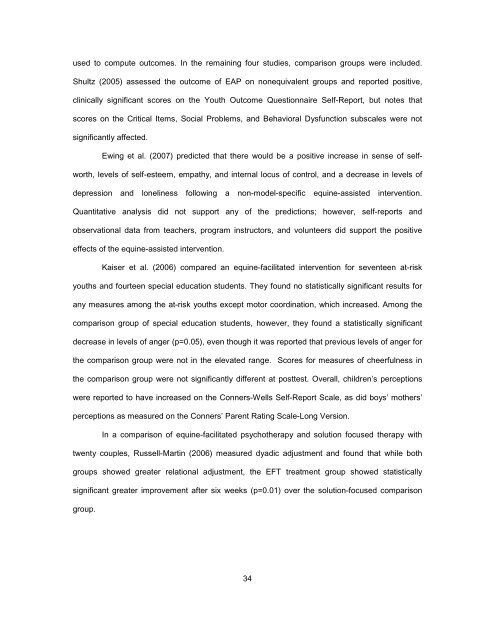A SYSTEMATIC REVIEW OF THE EFFECTS OF PSYCHOTHERAPY ...
A SYSTEMATIC REVIEW OF THE EFFECTS OF PSYCHOTHERAPY ...
A SYSTEMATIC REVIEW OF THE EFFECTS OF PSYCHOTHERAPY ...
You also want an ePaper? Increase the reach of your titles
YUMPU automatically turns print PDFs into web optimized ePapers that Google loves.
used to compute outcomes. In the remaining four studies, comparison groups were included.<br />
Shultz (2005) assessed the outcome of EAP on nonequivalent groups and reported positive,<br />
clinically significant scores on the Youth Outcome Questionnaire Self-Report, but notes that<br />
scores on the Critical Items, Social Problems, and Behavioral Dysfunction subscales were not<br />
significantly affected.<br />
Ewing et al. (2007) predicted that there would be a positive increase in sense of selfworth,<br />
levels of self-esteem, empathy, and internal locus of control, and a decrease in levels of<br />
depression and loneliness following a non-model-specific equine-assisted intervention.<br />
Quantitative analysis did not support any of the predictions; however, self-reports and<br />
observational data from teachers, program instructors, and volunteers did support the positive<br />
effects of the equine-assisted intervention.<br />
Kaiser et al. (2006) compared an equine-facilitated intervention for seventeen at-risk<br />
youths and fourteen special education students. They found no statistically significant results for<br />
any measures among the at-risk youths except motor coordination, which increased. Among the<br />
comparison group of special education students, however, they found a statistically significant<br />
decrease in levels of anger (p=0.05), even though it was reported that previous levels of anger for<br />
the comparison group were not in the elevated range. Scores for measures of cheerfulness in<br />
the comparison group were not significantly different at posttest. Overall, children’s perceptions<br />
were reported to have increased on the Conners-Wells Self-Report Scale, as did boys’ mothers’<br />
perceptions as measured on the Conners’ Parent Rating Scale-Long Version.<br />
In a comparison of equine-facilitated psychotherapy and solution focused therapy with<br />
twenty couples, Russell-Martin (2006) measured dyadic adjustment and found that while both<br />
groups showed greater relational adjustment, the EFT treatment group showed statistically<br />
significant greater improvement after six weeks (p=0.01) over the solution-focused comparison<br />
group.<br />
34
















